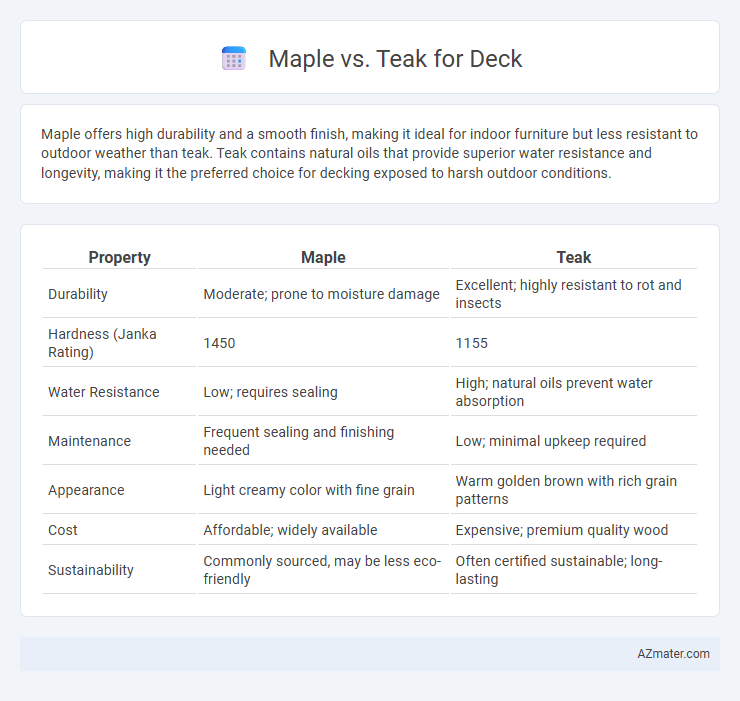Maple offers high durability and a smooth finish, making it ideal for indoor furniture but less resistant to outdoor weather than teak. Teak contains natural oils that provide superior water resistance and longevity, making it the preferred choice for decking exposed to harsh outdoor conditions.
Table of Comparison
| Property | Maple | Teak |
|---|---|---|
| Durability | Moderate; prone to moisture damage | Excellent; highly resistant to rot and insects |
| Hardness (Janka Rating) | 1450 | 1155 |
| Water Resistance | Low; requires sealing | High; natural oils prevent water absorption |
| Maintenance | Frequent sealing and finishing needed | Low; minimal upkeep required |
| Appearance | Light creamy color with fine grain | Warm golden brown with rich grain patterns |
| Cost | Affordable; widely available | Expensive; premium quality wood |
| Sustainability | Commonly sourced, may be less eco-friendly | Often certified sustainable; long-lasting |
Maple vs Teak: A Decking Material Comparison
Maple offers a hard, durable surface with a fine, uniform grain, making it resistant to dents and scratches, but it requires regular sealing to withstand outdoor moisture and UV rays. Teak contains natural oils that provide exceptional resistance to rot, insects, and water, making it ideal for outdoor decking with minimal maintenance. While teak commands a higher price point due to its durability and weather resistance, maple offers a more budget-friendly option with a lighter color palette and increased susceptibility to environmental wear.
Durability: Maple vs Teak for Outdoor Decks
Teak wood is renowned for its exceptional durability in outdoor decks due to its natural oils and dense grain, which resist rot, decay, and insect damage better than maple. Maple, while hard and strong, lacks the inherent moisture resistance of teak, making it more susceptible to warping and weathering over time without proper sealing. Investing in teak for outdoor decks ensures long-lasting performance with minimal maintenance compared to the more vulnerable maple wood.
Weather Resistance: Which Wood Performs Better?
Teak outperforms maple in weather resistance due to its natural oils and dense grain, making it highly resistant to moisture, rot, and insect damage. Maple's susceptibility to water absorption and warping under outdoor conditions reduces its durability compared to teak. Therefore, teak is the preferred wood for decks requiring long-term resilience against harsh weather elements.
Maintenance Requirements: Maple Deck vs Teak Deck
Maple decks require more frequent sealing and refinishing due to their susceptibility to moisture absorption and wear, necessitating annual maintenance to prevent cracking and warping. Teak decks offer superior natural oils that resist water, insects, and rot, reducing the need for regular sealing and making maintenance less intensive, typically requiring only periodic cleaning and occasional oiling. The durability and natural resistance of teak translate to lower overall upkeep compared to the higher maintenance demands of maple decks.
Appearance and Aesthetics: Maple vs Teak
Maple offers a light, uniform grain with a creamy, pale tone, providing a modern and clean aesthetic ideal for bright, contemporary decks. Teak features rich golden-brown hues with natural oils that create a warm, luxurious appearance and develop a graceful patina over time, enhancing its classic charm. While maple's smooth surface showcases a subtle elegance, teak's distinctive grain patterns and natural luster make it a timeless choice for high-end, visually striking decks.
Cost Comparison: Maple vs Teak for Deck Construction
Maple wood, commonly priced between $3 to $8 per square foot, offers a more budget-friendly option for deck construction compared to teak, which ranges from $15 to $30 per square foot due to its durability and natural oils. The initial investment in teak is higher but justified by its superior resistance to rot, insects, and weathering, reducing long-term maintenance costs. Maple requires more frequent sealing and care to maintain its appearance and longevity, potentially increasing total owner expenses despite lower upfront costs.
Sustainability and Environmental Impact
Maple decking is less sustainable due to slower growth rates and higher demand, leading to potential overharvesting and deforestation concerns. Teak is often considered more sustainable when sourced from certified plantations, as it regenerates quickly and requires fewer chemical treatments because of its natural oils. Choosing FSC-certified teak supports responsible forestry practices, minimizing environmental impact compared to non-certified maple options.
Installation and Workability Differences
Maple decks offer a smooth, dense grain that allows for precise cuts and easy shaping, making installation straightforward with standard woodworking tools. Teak's natural oils require specialized fasteners and pre-drilling to prevent staining and splitting, adding complexity to the installation process. Maple's consistent hardness provides excellent workability, while teak's durability demands more careful handling to avoid surface damage during fitting.
Longevity: Which Wood Lasts Longer on Decks?
Teak is renowned for its exceptional durability and natural resistance to moisture, decay, and insect damage, making it one of the longest-lasting woods for decks, often enduring 25 to 40 years with minimal maintenance. Maple, while hard and dense, lacks the natural oils and resistance found in teak, making it more susceptible to weathering, rot, and insect infestations, typically lasting around 10 to 15 years when used outdoors. For longevity on decks exposed to varying elements, teak significantly outperforms maple due to its inherent properties and proven outdoor resilience.
Best Use Cases: When to Choose Maple or Teak for Your Deck
Maple is ideal for decks in cooler climates where a smooth, fine-grained surface and affordable durability are desired, making it perfect for moderate foot traffic and indoor-outdoor transitional spaces. Teak excels in harsh weather conditions due to its natural oils and high resistance to moisture, insects, and decay, making it the best choice for outdoor decks exposed to sun, rain, and humidity. Choosing teak ensures longevity and low maintenance for coastal or tropical environments, while maple suits residential decks with seasonal use and less exposure to extreme elements.

Infographic: Maple vs Teak for Deck
 azmater.com
azmater.com